CPK HND Health & Social Care Unit 9: Service User Independence
VerifiedAdded on 2020/07/23
|13
|4046
|280
Report
AI Summary
This report delves into the multifaceted aspects of enabling service users to achieve independence within the health and social care sector. It begins by examining the influence of current laws, sector skills standards, and their impact on company policies and practices, including the Data Protection Act and Equality legislation. The report further analyzes factors that affect the promotion and maximization of patient rights, such as changes in laws and the role of effective communication among care workers. It explores factors contributing to the loss of independence, social exclusion, and non-participation, and how business systems and procedures can be managed to foster patient participation. Risk management policies, medication handling, and the balancing of service user rights are also evaluated. The report highlights the importance of communication, training, and development in delivering quality services and ensuring patient satisfaction within the NHS framework.
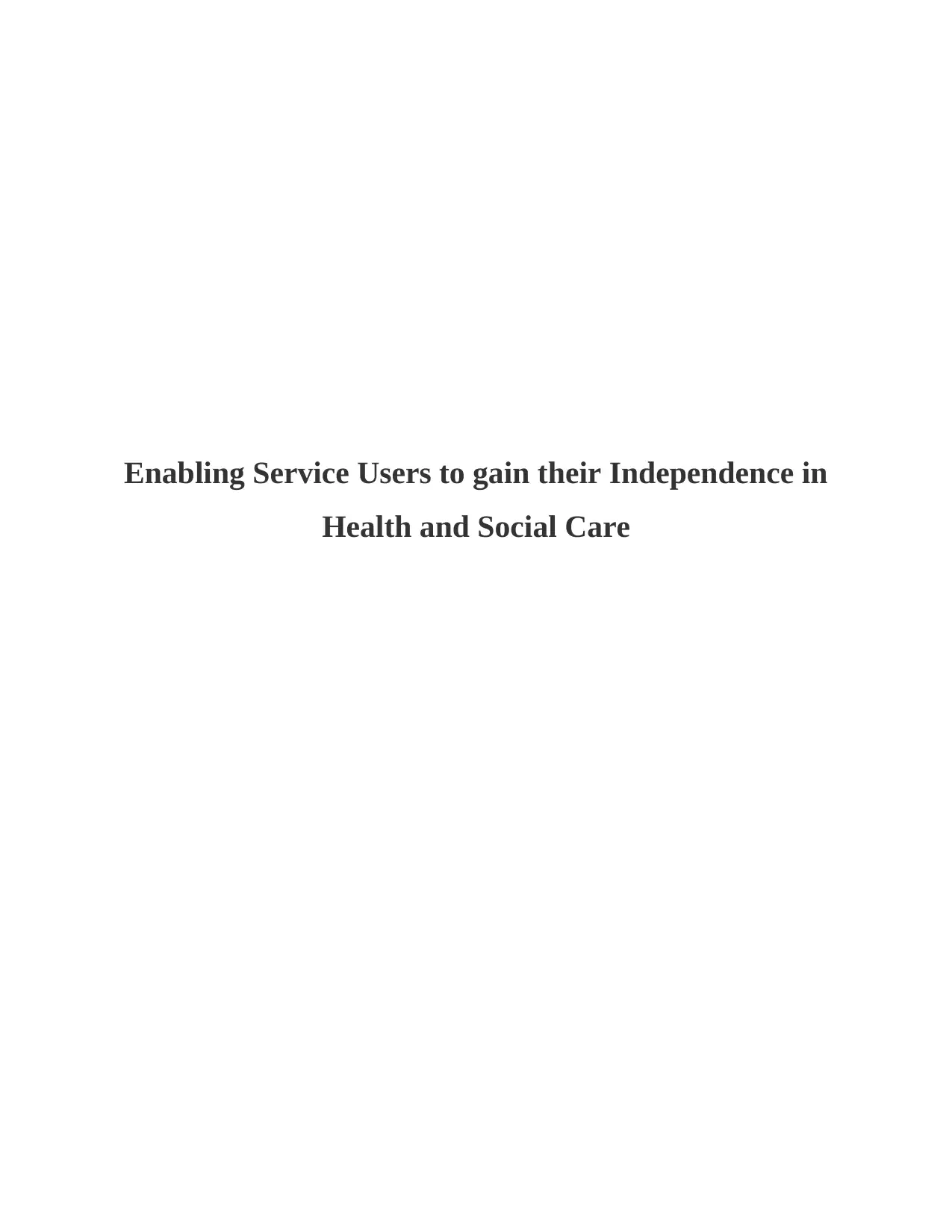
Enabling Service Users to gain their Independence in
Health and Social Care
Health and Social Care
Paraphrase This Document
Need a fresh take? Get an instant paraphrase of this document with our AI Paraphraser
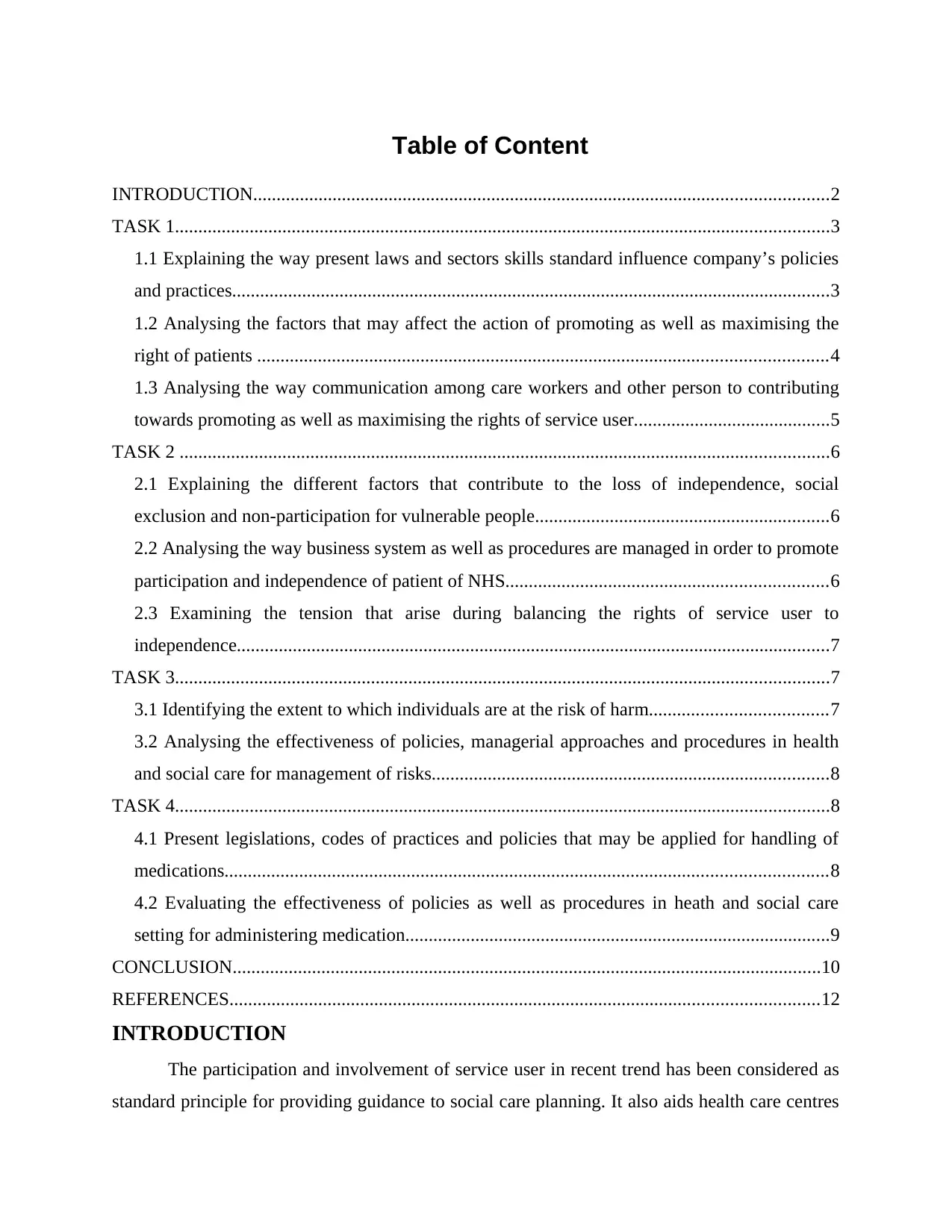
Table of Content
INTRODUCTION...........................................................................................................................2
TASK 1............................................................................................................................................3
1.1 Explaining the way present laws and sectors skills standard influence company’s policies
and practices................................................................................................................................3
1.2 Analysing the factors that may affect the action of promoting as well as maximising the
right of patients ..........................................................................................................................4
1.3 Analysing the way communication among care workers and other person to contributing
towards promoting as well as maximising the rights of service user..........................................5
TASK 2 ...........................................................................................................................................6
2.1 Explaining the different factors that contribute to the loss of independence, social
exclusion and non-participation for vulnerable people...............................................................6
2.2 Analysing the way business system as well as procedures are managed in order to promote
participation and independence of patient of NHS.....................................................................6
2.3 Examining the tension that arise during balancing the rights of service user to
independence...............................................................................................................................7
TASK 3............................................................................................................................................7
3.1 Identifying the extent to which individuals are at the risk of harm......................................7
3.2 Analysing the effectiveness of policies, managerial approaches and procedures in health
and social care for management of risks.....................................................................................8
TASK 4............................................................................................................................................8
4.1 Present legislations, codes of practices and policies that may be applied for handling of
medications.................................................................................................................................8
4.2 Evaluating the effectiveness of policies as well as procedures in heath and social care
setting for administering medication...........................................................................................9
CONCLUSION..............................................................................................................................10
REFERENCES..............................................................................................................................12
INTRODUCTION
The participation and involvement of service user in recent trend has been considered as
standard principle for providing guidance to social care planning. It also aids health care centres
INTRODUCTION...........................................................................................................................2
TASK 1............................................................................................................................................3
1.1 Explaining the way present laws and sectors skills standard influence company’s policies
and practices................................................................................................................................3
1.2 Analysing the factors that may affect the action of promoting as well as maximising the
right of patients ..........................................................................................................................4
1.3 Analysing the way communication among care workers and other person to contributing
towards promoting as well as maximising the rights of service user..........................................5
TASK 2 ...........................................................................................................................................6
2.1 Explaining the different factors that contribute to the loss of independence, social
exclusion and non-participation for vulnerable people...............................................................6
2.2 Analysing the way business system as well as procedures are managed in order to promote
participation and independence of patient of NHS.....................................................................6
2.3 Examining the tension that arise during balancing the rights of service user to
independence...............................................................................................................................7
TASK 3............................................................................................................................................7
3.1 Identifying the extent to which individuals are at the risk of harm......................................7
3.2 Analysing the effectiveness of policies, managerial approaches and procedures in health
and social care for management of risks.....................................................................................8
TASK 4............................................................................................................................................8
4.1 Present legislations, codes of practices and policies that may be applied for handling of
medications.................................................................................................................................8
4.2 Evaluating the effectiveness of policies as well as procedures in heath and social care
setting for administering medication...........................................................................................9
CONCLUSION..............................................................................................................................10
REFERENCES..............................................................................................................................12
INTRODUCTION
The participation and involvement of service user in recent trend has been considered as
standard principle for providing guidance to social care planning. It also aids health care centres
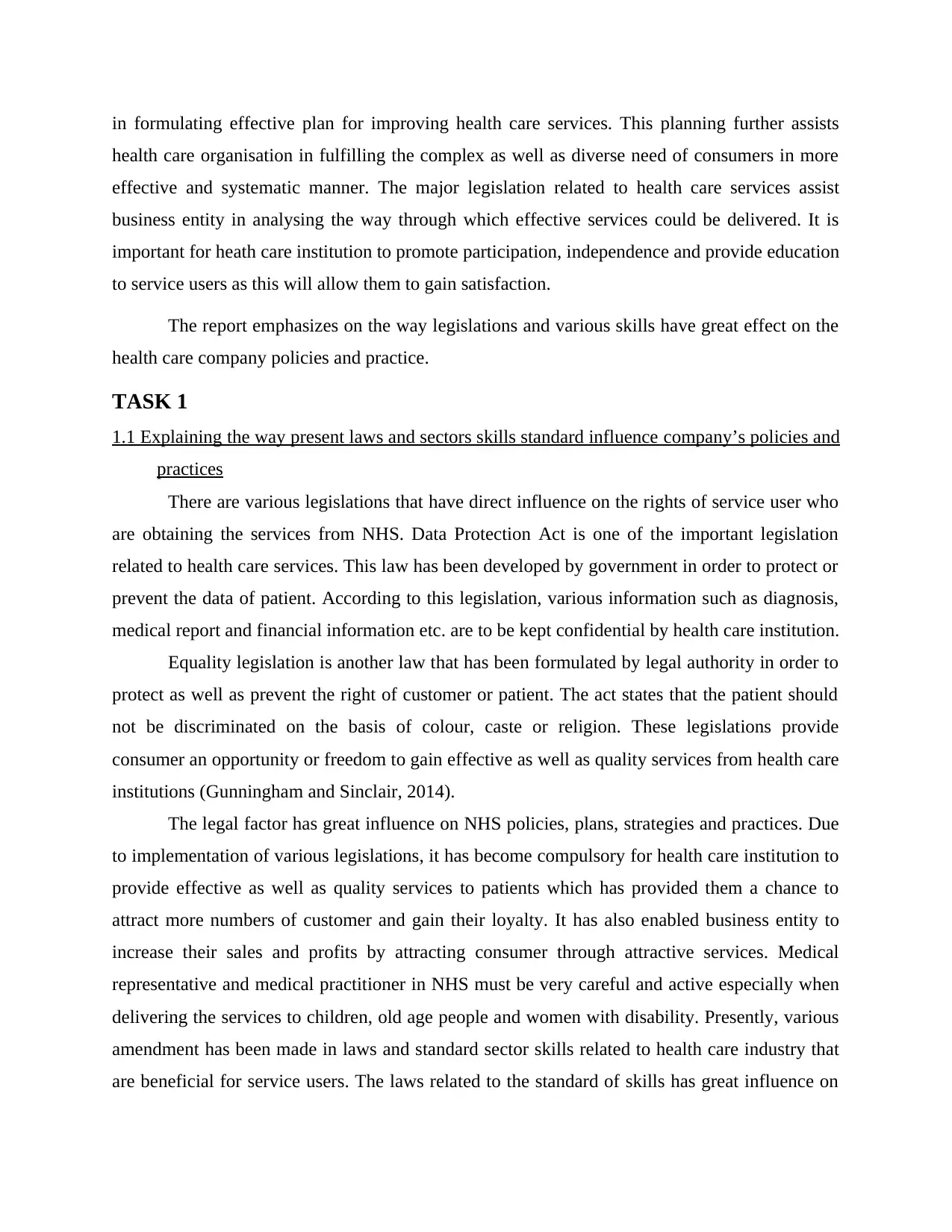
in formulating effective plan for improving health care services. This planning further assists
health care organisation in fulfilling the complex as well as diverse need of consumers in more
effective and systematic manner. The major legislation related to health care services assist
business entity in analysing the way through which effective services could be delivered. It is
important for heath care institution to promote participation, independence and provide education
to service users as this will allow them to gain satisfaction.
The report emphasizes on the way legislations and various skills have great effect on the
health care company policies and practice.
TASK 1
1.1 Explaining the way present laws and sectors skills standard influence company’s policies and
practices
There are various legislations that have direct influence on the rights of service user who
are obtaining the services from NHS. Data Protection Act is one of the important legislation
related to health care services. This law has been developed by government in order to protect or
prevent the data of patient. According to this legislation, various information such as diagnosis,
medical report and financial information etc. are to be kept confidential by health care institution.
Equality legislation is another law that has been formulated by legal authority in order to
protect as well as prevent the right of customer or patient. The act states that the patient should
not be discriminated on the basis of colour, caste or religion. These legislations provide
consumer an opportunity or freedom to gain effective as well as quality services from health care
institutions (Gunningham and Sinclair, 2014).
The legal factor has great influence on NHS policies, plans, strategies and practices. Due
to implementation of various legislations, it has become compulsory for health care institution to
provide effective as well as quality services to patients which has provided them a chance to
attract more numbers of customer and gain their loyalty. It has also enabled business entity to
increase their sales and profits by attracting consumer through attractive services. Medical
representative and medical practitioner in NHS must be very careful and active especially when
delivering the services to children, old age people and women with disability. Presently, various
amendment has been made in laws and standard sector skills related to health care industry that
are beneficial for service users. The laws related to the standard of skills has great influence on
health care organisation in fulfilling the complex as well as diverse need of consumers in more
effective and systematic manner. The major legislation related to health care services assist
business entity in analysing the way through which effective services could be delivered. It is
important for heath care institution to promote participation, independence and provide education
to service users as this will allow them to gain satisfaction.
The report emphasizes on the way legislations and various skills have great effect on the
health care company policies and practice.
TASK 1
1.1 Explaining the way present laws and sectors skills standard influence company’s policies and
practices
There are various legislations that have direct influence on the rights of service user who
are obtaining the services from NHS. Data Protection Act is one of the important legislation
related to health care services. This law has been developed by government in order to protect or
prevent the data of patient. According to this legislation, various information such as diagnosis,
medical report and financial information etc. are to be kept confidential by health care institution.
Equality legislation is another law that has been formulated by legal authority in order to
protect as well as prevent the right of customer or patient. The act states that the patient should
not be discriminated on the basis of colour, caste or religion. These legislations provide
consumer an opportunity or freedom to gain effective as well as quality services from health care
institutions (Gunningham and Sinclair, 2014).
The legal factor has great influence on NHS policies, plans, strategies and practices. Due
to implementation of various legislations, it has become compulsory for health care institution to
provide effective as well as quality services to patients which has provided them a chance to
attract more numbers of customer and gain their loyalty. It has also enabled business entity to
increase their sales and profits by attracting consumer through attractive services. Medical
representative and medical practitioner in NHS must be very careful and active especially when
delivering the services to children, old age people and women with disability. Presently, various
amendment has been made in laws and standard sector skills related to health care industry that
are beneficial for service users. The laws related to the standard of skills has great influence on
⊘ This is a preview!⊘
Do you want full access?
Subscribe today to unlock all pages.

Trusted by 1+ million students worldwide
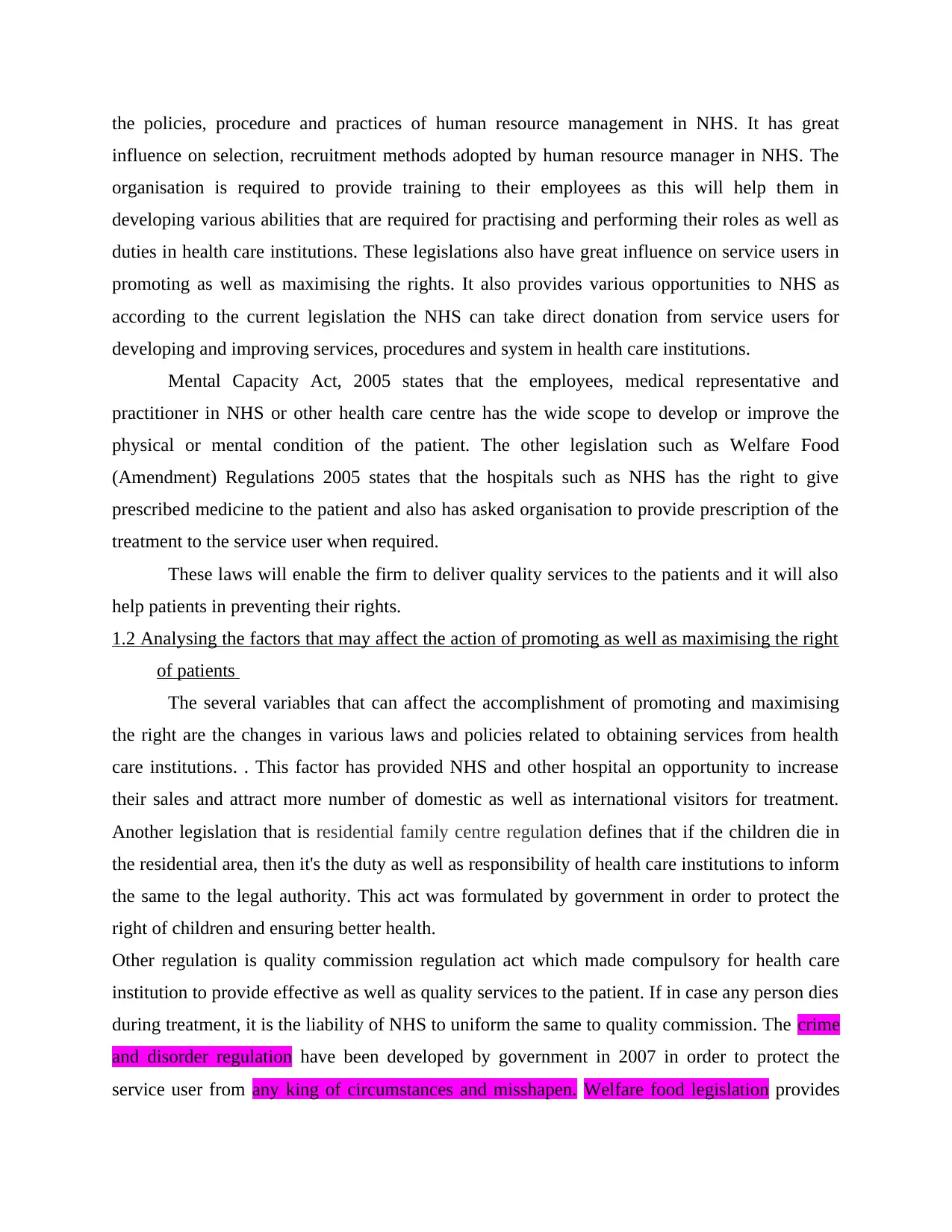
the policies, procedure and practices of human resource management in NHS. It has great
influence on selection, recruitment methods adopted by human resource manager in NHS. The
organisation is required to provide training to their employees as this will help them in
developing various abilities that are required for practising and performing their roles as well as
duties in health care institutions. These legislations also have great influence on service users in
promoting as well as maximising the rights. It also provides various opportunities to NHS as
according to the current legislation the NHS can take direct donation from service users for
developing and improving services, procedures and system in health care institutions.
Mental Capacity Act, 2005 states that the employees, medical representative and
practitioner in NHS or other health care centre has the wide scope to develop or improve the
physical or mental condition of the patient. The other legislation such as Welfare Food
(Amendment) Regulations 2005 states that the hospitals such as NHS has the right to give
prescribed medicine to the patient and also has asked organisation to provide prescription of the
treatment to the service user when required.
These laws will enable the firm to deliver quality services to the patients and it will also
help patients in preventing their rights.
1.2 Analysing the factors that may affect the action of promoting as well as maximising the right
of patients
The several variables that can affect the accomplishment of promoting and maximising
the right are the changes in various laws and policies related to obtaining services from health
care institutions. . This factor has provided NHS and other hospital an opportunity to increase
their sales and attract more number of domestic as well as international visitors for treatment.
Another legislation that is residential family centre regulation defines that if the children die in
the residential area, then it's the duty as well as responsibility of health care institutions to inform
the same to the legal authority. This act was formulated by government in order to protect the
right of children and ensuring better health.
Other regulation is quality commission regulation act which made compulsory for health care
institution to provide effective as well as quality services to the patient. If in case any person dies
during treatment, it is the liability of NHS to uniform the same to quality commission. The crime
and disorder regulation have been developed by government in 2007 in order to protect the
service user from any king of circumstances and misshapen. Welfare food legislation provides
influence on selection, recruitment methods adopted by human resource manager in NHS. The
organisation is required to provide training to their employees as this will help them in
developing various abilities that are required for practising and performing their roles as well as
duties in health care institutions. These legislations also have great influence on service users in
promoting as well as maximising the rights. It also provides various opportunities to NHS as
according to the current legislation the NHS can take direct donation from service users for
developing and improving services, procedures and system in health care institutions.
Mental Capacity Act, 2005 states that the employees, medical representative and
practitioner in NHS or other health care centre has the wide scope to develop or improve the
physical or mental condition of the patient. The other legislation such as Welfare Food
(Amendment) Regulations 2005 states that the hospitals such as NHS has the right to give
prescribed medicine to the patient and also has asked organisation to provide prescription of the
treatment to the service user when required.
These laws will enable the firm to deliver quality services to the patients and it will also
help patients in preventing their rights.
1.2 Analysing the factors that may affect the action of promoting as well as maximising the right
of patients
The several variables that can affect the accomplishment of promoting and maximising
the right are the changes in various laws and policies related to obtaining services from health
care institutions. . This factor has provided NHS and other hospital an opportunity to increase
their sales and attract more number of domestic as well as international visitors for treatment.
Another legislation that is residential family centre regulation defines that if the children die in
the residential area, then it's the duty as well as responsibility of health care institutions to inform
the same to the legal authority. This act was formulated by government in order to protect the
right of children and ensuring better health.
Other regulation is quality commission regulation act which made compulsory for health care
institution to provide effective as well as quality services to the patient. If in case any person dies
during treatment, it is the liability of NHS to uniform the same to quality commission. The crime
and disorder regulation have been developed by government in 2007 in order to protect the
service user from any king of circumstances and misshapen. Welfare food legislation provides
Paraphrase This Document
Need a fresh take? Get an instant paraphrase of this document with our AI Paraphraser
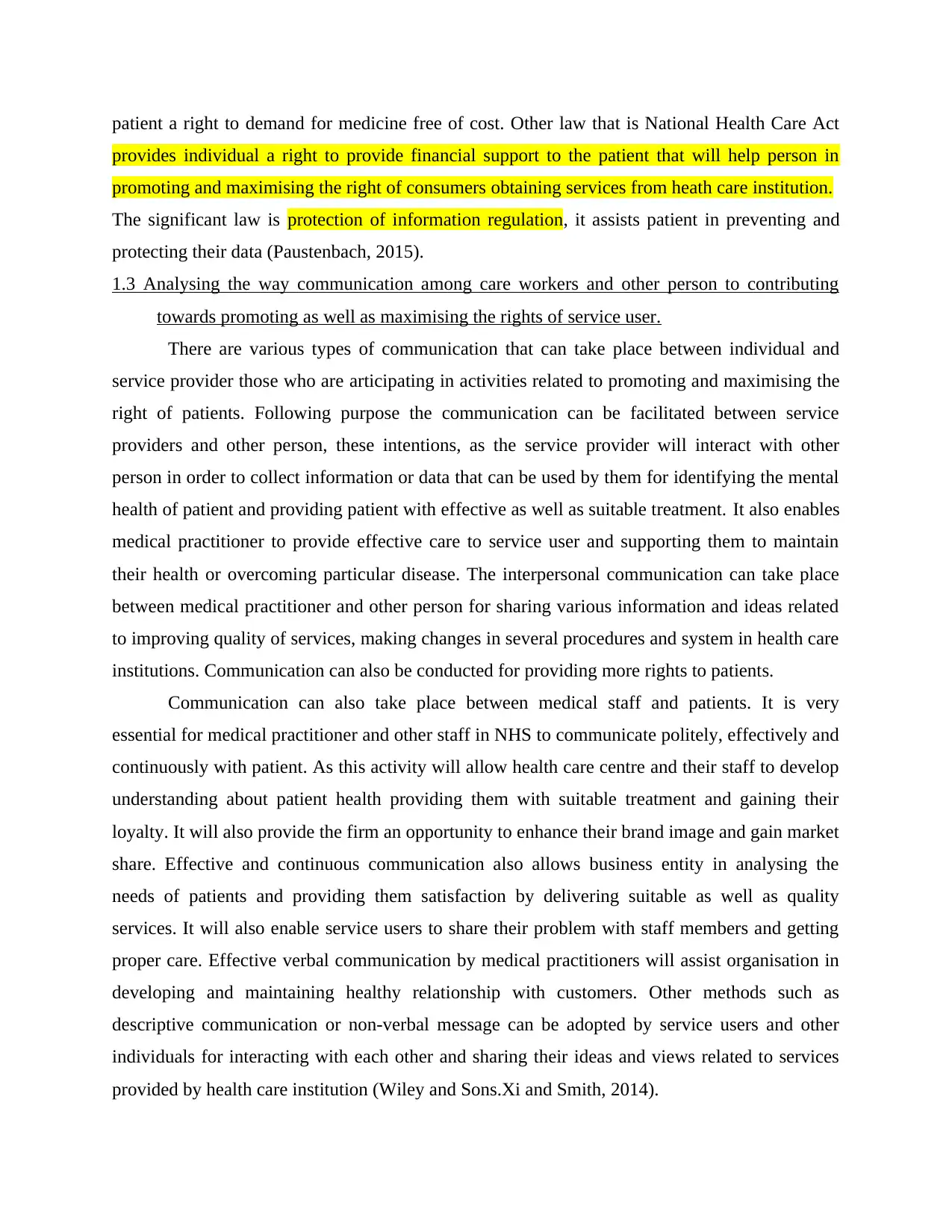
patient a right to demand for medicine free of cost. Other law that is National Health Care Act
provides individual a right to provide financial support to the patient that will help person in
promoting and maximising the right of consumers obtaining services from heath care institution.
The significant law is protection of information regulation, it assists patient in preventing and
protecting their data (Paustenbach, 2015).
1.3 Analysing the way communication among care workers and other person to contributing
towards promoting as well as maximising the rights of service user.
There are various types of communication that can take place between individual and
service provider those who are articipating in activities related to promoting and maximising the
right of patients. Following purpose the communication can be facilitated between service
providers and other person, these intentions, as the service provider will interact with other
person in order to collect information or data that can be used by them for identifying the mental
health of patient and providing patient with effective as well as suitable treatment. It also enables
medical practitioner to provide effective care to service user and supporting them to maintain
their health or overcoming particular disease. The interpersonal communication can take place
between medical practitioner and other person for sharing various information and ideas related
to improving quality of services, making changes in several procedures and system in health care
institutions. Communication can also be conducted for providing more rights to patients.
Communication can also take place between medical staff and patients. It is very
essential for medical practitioner and other staff in NHS to communicate politely, effectively and
continuously with patient. As this activity will allow health care centre and their staff to develop
understanding about patient health providing them with suitable treatment and gaining their
loyalty. It will also provide the firm an opportunity to enhance their brand image and gain market
share. Effective and continuous communication also allows business entity in analysing the
needs of patients and providing them satisfaction by delivering suitable as well as quality
services. It will also enable service users to share their problem with staff members and getting
proper care. Effective verbal communication by medical practitioners will assist organisation in
developing and maintaining healthy relationship with customers. Other methods such as
descriptive communication or non-verbal message can be adopted by service users and other
individuals for interacting with each other and sharing their ideas and views related to services
provided by health care institution (Wiley and Sons.Xi and Smith, 2014).
provides individual a right to provide financial support to the patient that will help person in
promoting and maximising the right of consumers obtaining services from heath care institution.
The significant law is protection of information regulation, it assists patient in preventing and
protecting their data (Paustenbach, 2015).
1.3 Analysing the way communication among care workers and other person to contributing
towards promoting as well as maximising the rights of service user.
There are various types of communication that can take place between individual and
service provider those who are articipating in activities related to promoting and maximising the
right of patients. Following purpose the communication can be facilitated between service
providers and other person, these intentions, as the service provider will interact with other
person in order to collect information or data that can be used by them for identifying the mental
health of patient and providing patient with effective as well as suitable treatment. It also enables
medical practitioner to provide effective care to service user and supporting them to maintain
their health or overcoming particular disease. The interpersonal communication can take place
between medical practitioner and other person for sharing various information and ideas related
to improving quality of services, making changes in several procedures and system in health care
institutions. Communication can also be conducted for providing more rights to patients.
Communication can also take place between medical staff and patients. It is very
essential for medical practitioner and other staff in NHS to communicate politely, effectively and
continuously with patient. As this activity will allow health care centre and their staff to develop
understanding about patient health providing them with suitable treatment and gaining their
loyalty. It will also provide the firm an opportunity to enhance their brand image and gain market
share. Effective and continuous communication also allows business entity in analysing the
needs of patients and providing them satisfaction by delivering suitable as well as quality
services. It will also enable service users to share their problem with staff members and getting
proper care. Effective verbal communication by medical practitioners will assist organisation in
developing and maintaining healthy relationship with customers. Other methods such as
descriptive communication or non-verbal message can be adopted by service users and other
individuals for interacting with each other and sharing their ideas and views related to services
provided by health care institution (Wiley and Sons.Xi and Smith, 2014).
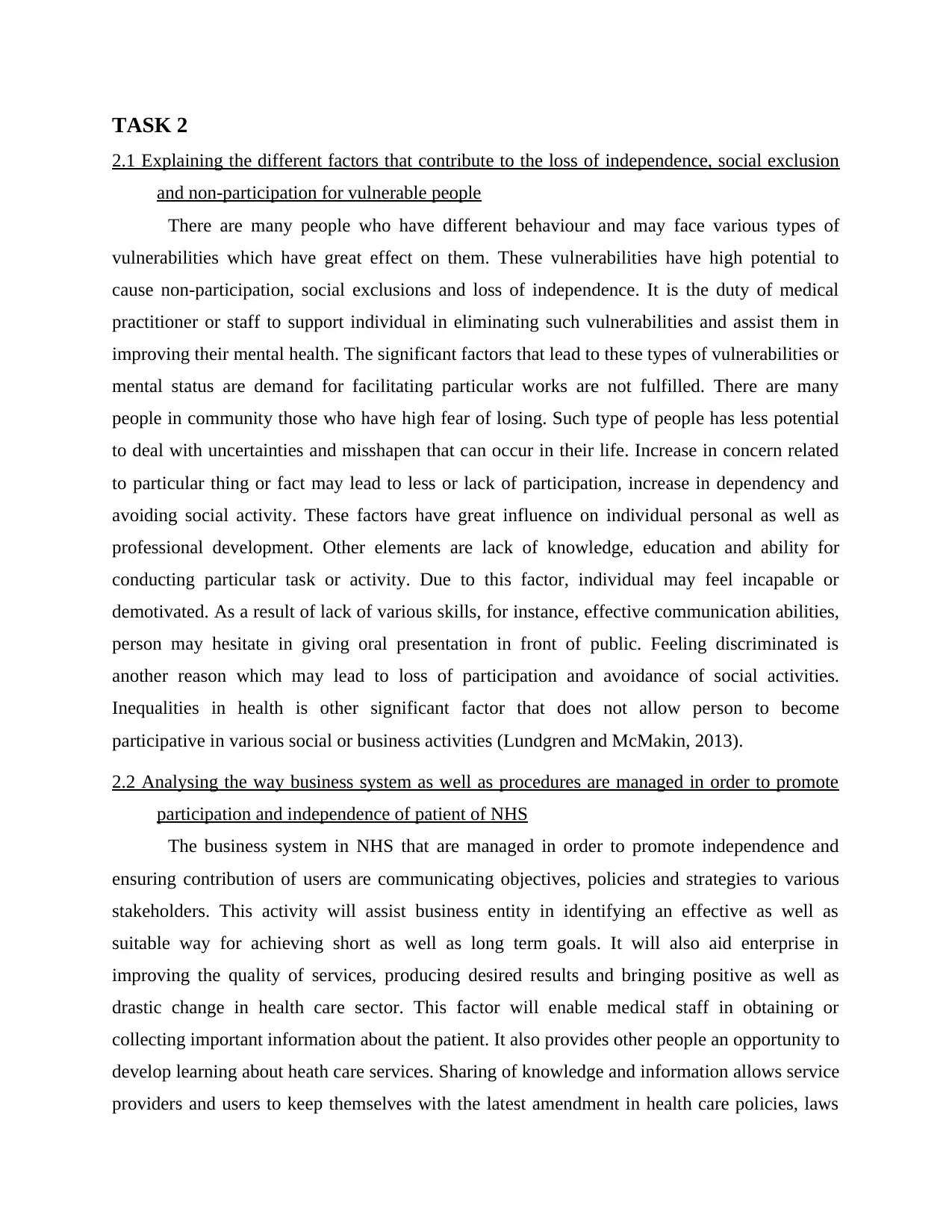
TASK 2
2.1 Explaining the different factors that contribute to the loss of independence, social exclusion
and non-participation for vulnerable people
There are many people who have different behaviour and may face various types of
vulnerabilities which have great effect on them. These vulnerabilities have high potential to
cause non-participation, social exclusions and loss of independence. It is the duty of medical
practitioner or staff to support individual in eliminating such vulnerabilities and assist them in
improving their mental health. The significant factors that lead to these types of vulnerabilities or
mental status are demand for facilitating particular works are not fulfilled. There are many
people in community those who have high fear of losing. Such type of people has less potential
to deal with uncertainties and misshapen that can occur in their life. Increase in concern related
to particular thing or fact may lead to less or lack of participation, increase in dependency and
avoiding social activity. These factors have great influence on individual personal as well as
professional development. Other elements are lack of knowledge, education and ability for
conducting particular task or activity. Due to this factor, individual may feel incapable or
demotivated. As a result of lack of various skills, for instance, effective communication abilities,
person may hesitate in giving oral presentation in front of public. Feeling discriminated is
another reason which may lead to loss of participation and avoidance of social activities.
Inequalities in health is other significant factor that does not allow person to become
participative in various social or business activities (Lundgren and McMakin, 2013).
2.2 Analysing the way business system as well as procedures are managed in order to promote
participation and independence of patient of NHS
The business system in NHS that are managed in order to promote independence and
ensuring contribution of users are communicating objectives, policies and strategies to various
stakeholders. This activity will assist business entity in identifying an effective as well as
suitable way for achieving short as well as long term goals. It will also aid enterprise in
improving the quality of services, producing desired results and bringing positive as well as
drastic change in health care sector. This factor will enable medical staff in obtaining or
collecting important information about the patient. It also provides other people an opportunity to
develop learning about heath care services. Sharing of knowledge and information allows service
providers and users to keep themselves with the latest amendment in health care policies, laws
2.1 Explaining the different factors that contribute to the loss of independence, social exclusion
and non-participation for vulnerable people
There are many people who have different behaviour and may face various types of
vulnerabilities which have great effect on them. These vulnerabilities have high potential to
cause non-participation, social exclusions and loss of independence. It is the duty of medical
practitioner or staff to support individual in eliminating such vulnerabilities and assist them in
improving their mental health. The significant factors that lead to these types of vulnerabilities or
mental status are demand for facilitating particular works are not fulfilled. There are many
people in community those who have high fear of losing. Such type of people has less potential
to deal with uncertainties and misshapen that can occur in their life. Increase in concern related
to particular thing or fact may lead to less or lack of participation, increase in dependency and
avoiding social activity. These factors have great influence on individual personal as well as
professional development. Other elements are lack of knowledge, education and ability for
conducting particular task or activity. Due to this factor, individual may feel incapable or
demotivated. As a result of lack of various skills, for instance, effective communication abilities,
person may hesitate in giving oral presentation in front of public. Feeling discriminated is
another reason which may lead to loss of participation and avoidance of social activities.
Inequalities in health is other significant factor that does not allow person to become
participative in various social or business activities (Lundgren and McMakin, 2013).
2.2 Analysing the way business system as well as procedures are managed in order to promote
participation and independence of patient of NHS
The business system in NHS that are managed in order to promote independence and
ensuring contribution of users are communicating objectives, policies and strategies to various
stakeholders. This activity will assist business entity in identifying an effective as well as
suitable way for achieving short as well as long term goals. It will also aid enterprise in
improving the quality of services, producing desired results and bringing positive as well as
drastic change in health care sector. This factor will enable medical staff in obtaining or
collecting important information about the patient. It also provides other people an opportunity to
develop learning about heath care services. Sharing of knowledge and information allows service
providers and users to keep themselves with the latest amendment in health care policies, laws
⊘ This is a preview!⊘
Do you want full access?
Subscribe today to unlock all pages.

Trusted by 1+ million students worldwide
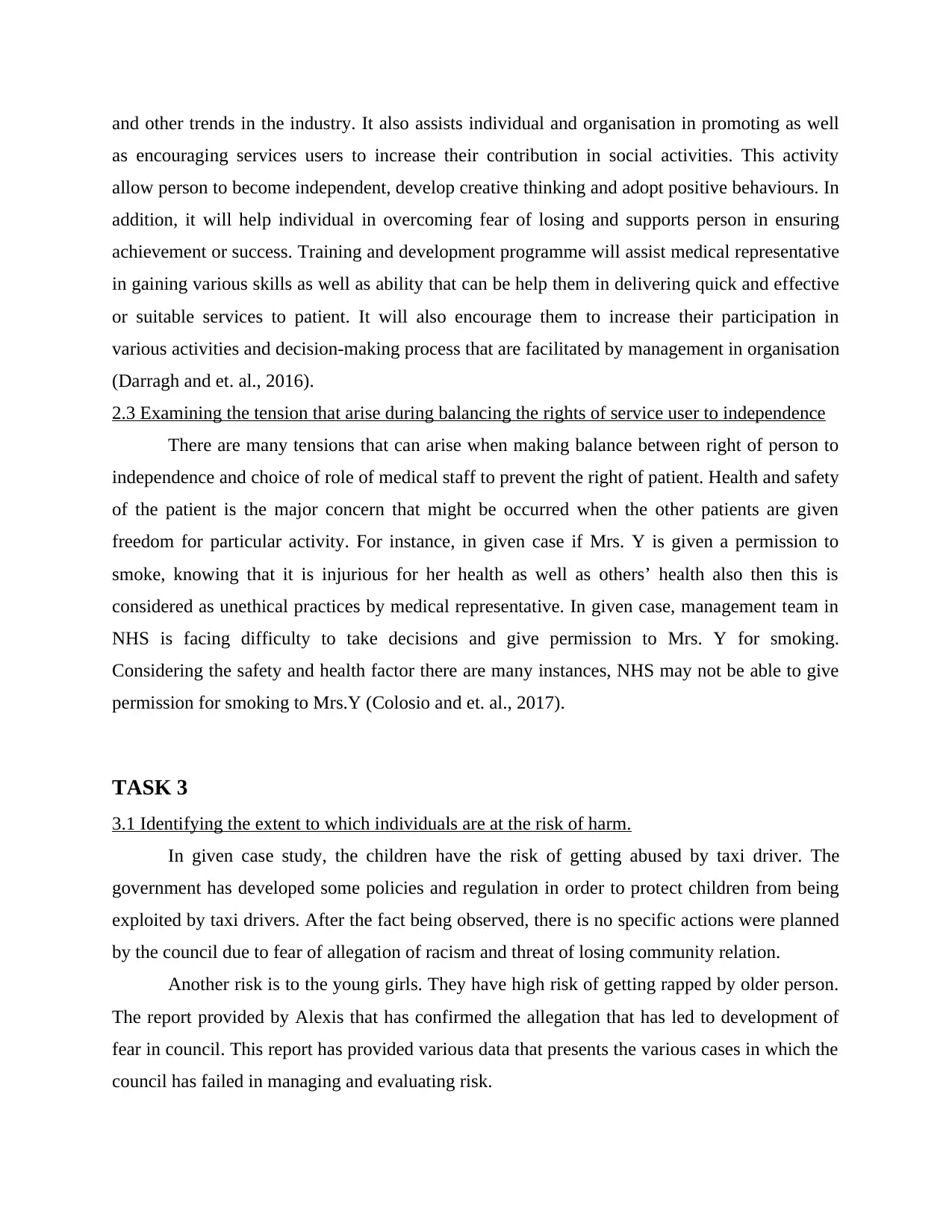
and other trends in the industry. It also assists individual and organisation in promoting as well
as encouraging services users to increase their contribution in social activities. This activity
allow person to become independent, develop creative thinking and adopt positive behaviours. In
addition, it will help individual in overcoming fear of losing and supports person in ensuring
achievement or success. Training and development programme will assist medical representative
in gaining various skills as well as ability that can be help them in delivering quick and effective
or suitable services to patient. It will also encourage them to increase their participation in
various activities and decision-making process that are facilitated by management in organisation
(Darragh and et. al., 2016).
2.3 Examining the tension that arise during balancing the rights of service user to independence
There are many tensions that can arise when making balance between right of person to
independence and choice of role of medical staff to prevent the right of patient. Health and safety
of the patient is the major concern that might be occurred when the other patients are given
freedom for particular activity. For instance, in given case if Mrs. Y is given a permission to
smoke, knowing that it is injurious for her health as well as others’ health also then this is
considered as unethical practices by medical representative. In given case, management team in
NHS is facing difficulty to take decisions and give permission to Mrs. Y for smoking.
Considering the safety and health factor there are many instances, NHS may not be able to give
permission for smoking to Mrs.Y (Colosio and et. al., 2017).
TASK 3
3.1 Identifying the extent to which individuals are at the risk of harm.
In given case study, the children have the risk of getting abused by taxi driver. The
government has developed some policies and regulation in order to protect children from being
exploited by taxi drivers. After the fact being observed, there is no specific actions were planned
by the council due to fear of allegation of racism and threat of losing community relation.
Another risk is to the young girls. They have high risk of getting rapped by older person.
The report provided by Alexis that has confirmed the allegation that has led to development of
fear in council. This report has provided various data that presents the various cases in which the
council has failed in managing and evaluating risk.
as encouraging services users to increase their contribution in social activities. This activity
allow person to become independent, develop creative thinking and adopt positive behaviours. In
addition, it will help individual in overcoming fear of losing and supports person in ensuring
achievement or success. Training and development programme will assist medical representative
in gaining various skills as well as ability that can be help them in delivering quick and effective
or suitable services to patient. It will also encourage them to increase their participation in
various activities and decision-making process that are facilitated by management in organisation
(Darragh and et. al., 2016).
2.3 Examining the tension that arise during balancing the rights of service user to independence
There are many tensions that can arise when making balance between right of person to
independence and choice of role of medical staff to prevent the right of patient. Health and safety
of the patient is the major concern that might be occurred when the other patients are given
freedom for particular activity. For instance, in given case if Mrs. Y is given a permission to
smoke, knowing that it is injurious for her health as well as others’ health also then this is
considered as unethical practices by medical representative. In given case, management team in
NHS is facing difficulty to take decisions and give permission to Mrs. Y for smoking.
Considering the safety and health factor there are many instances, NHS may not be able to give
permission for smoking to Mrs.Y (Colosio and et. al., 2017).
TASK 3
3.1 Identifying the extent to which individuals are at the risk of harm.
In given case study, the children have the risk of getting abused by taxi driver. The
government has developed some policies and regulation in order to protect children from being
exploited by taxi drivers. After the fact being observed, there is no specific actions were planned
by the council due to fear of allegation of racism and threat of losing community relation.
Another risk is to the young girls. They have high risk of getting rapped by older person.
The report provided by Alexis that has confirmed the allegation that has led to development of
fear in council. This report has provided various data that presents the various cases in which the
council has failed in managing and evaluating risk.
Paraphrase This Document
Need a fresh take? Get an instant paraphrase of this document with our AI Paraphraser
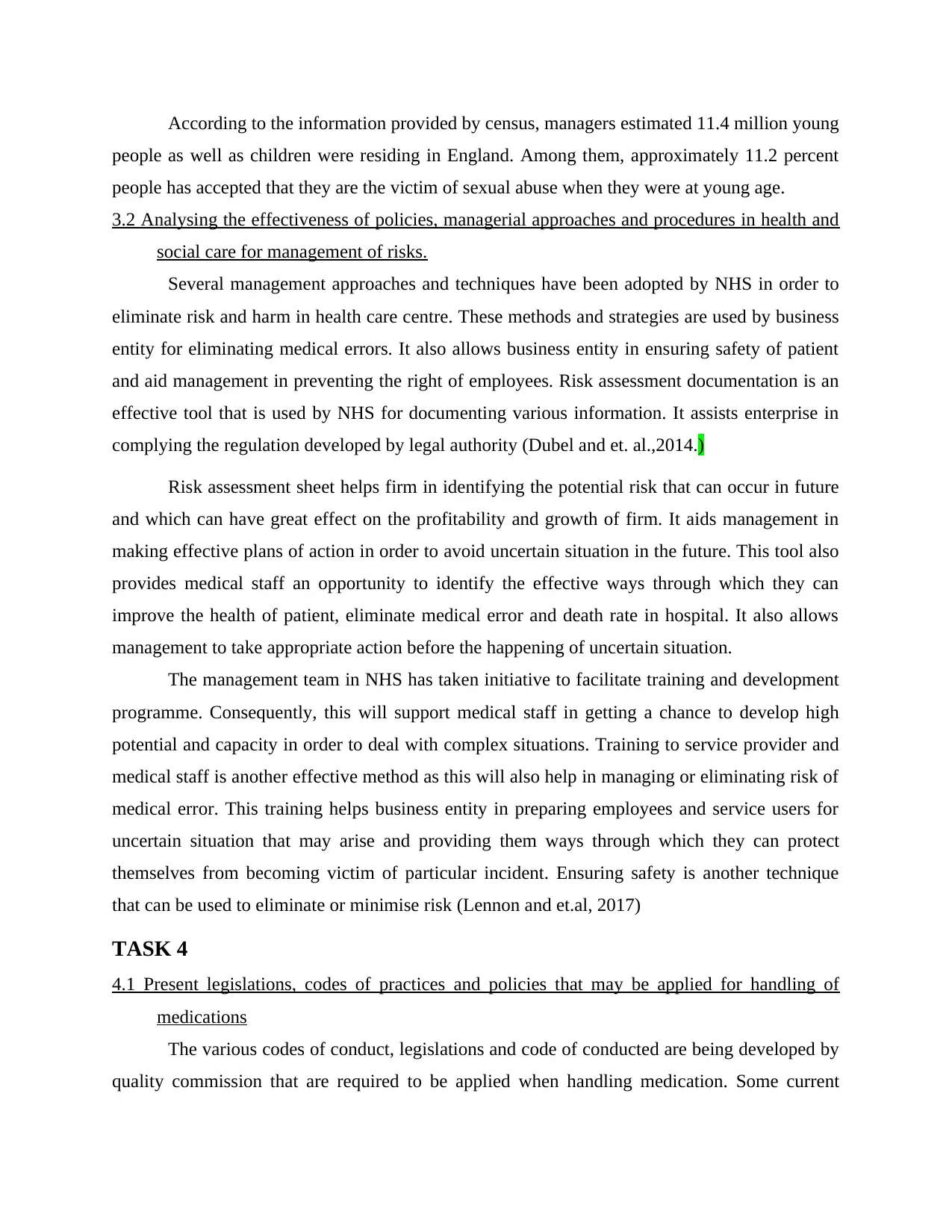
According to the information provided by census, managers estimated 11.4 million young
people as well as children were residing in England. Among them, approximately 11.2 percent
people has accepted that they are the victim of sexual abuse when they were at young age.
3.2 Analysing the effectiveness of policies, managerial approaches and procedures in health and
social care for management of risks.
Several management approaches and techniques have been adopted by NHS in order to
eliminate risk and harm in health care centre. These methods and strategies are used by business
entity for eliminating medical errors. It also allows business entity in ensuring safety of patient
and aid management in preventing the right of employees. Risk assessment documentation is an
effective tool that is used by NHS for documenting various information. It assists enterprise in
complying the regulation developed by legal authority (Dubel and et. al.,2014.)
Risk assessment sheet helps firm in identifying the potential risk that can occur in future
and which can have great effect on the profitability and growth of firm. It aids management in
making effective plans of action in order to avoid uncertain situation in the future. This tool also
provides medical staff an opportunity to identify the effective ways through which they can
improve the health of patient, eliminate medical error and death rate in hospital. It also allows
management to take appropriate action before the happening of uncertain situation.
The management team in NHS has taken initiative to facilitate training and development
programme. Consequently, this will support medical staff in getting a chance to develop high
potential and capacity in order to deal with complex situations. Training to service provider and
medical staff is another effective method as this will also help in managing or eliminating risk of
medical error. This training helps business entity in preparing employees and service users for
uncertain situation that may arise and providing them ways through which they can protect
themselves from becoming victim of particular incident. Ensuring safety is another technique
that can be used to eliminate or minimise risk (Lennon and et.al, 2017)
TASK 4
4.1 Present legislations, codes of practices and policies that may be applied for handling of
medications
The various codes of conduct, legislations and code of conducted are being developed by
quality commission that are required to be applied when handling medication. Some current
people as well as children were residing in England. Among them, approximately 11.2 percent
people has accepted that they are the victim of sexual abuse when they were at young age.
3.2 Analysing the effectiveness of policies, managerial approaches and procedures in health and
social care for management of risks.
Several management approaches and techniques have been adopted by NHS in order to
eliminate risk and harm in health care centre. These methods and strategies are used by business
entity for eliminating medical errors. It also allows business entity in ensuring safety of patient
and aid management in preventing the right of employees. Risk assessment documentation is an
effective tool that is used by NHS for documenting various information. It assists enterprise in
complying the regulation developed by legal authority (Dubel and et. al.,2014.)
Risk assessment sheet helps firm in identifying the potential risk that can occur in future
and which can have great effect on the profitability and growth of firm. It aids management in
making effective plans of action in order to avoid uncertain situation in the future. This tool also
provides medical staff an opportunity to identify the effective ways through which they can
improve the health of patient, eliminate medical error and death rate in hospital. It also allows
management to take appropriate action before the happening of uncertain situation.
The management team in NHS has taken initiative to facilitate training and development
programme. Consequently, this will support medical staff in getting a chance to develop high
potential and capacity in order to deal with complex situations. Training to service provider and
medical staff is another effective method as this will also help in managing or eliminating risk of
medical error. This training helps business entity in preparing employees and service users for
uncertain situation that may arise and providing them ways through which they can protect
themselves from becoming victim of particular incident. Ensuring safety is another technique
that can be used to eliminate or minimise risk (Lennon and et.al, 2017)
TASK 4
4.1 Present legislations, codes of practices and policies that may be applied for handling of
medications
The various codes of conduct, legislations and code of conducted are being developed by
quality commission that are required to be applied when handling medication. Some current
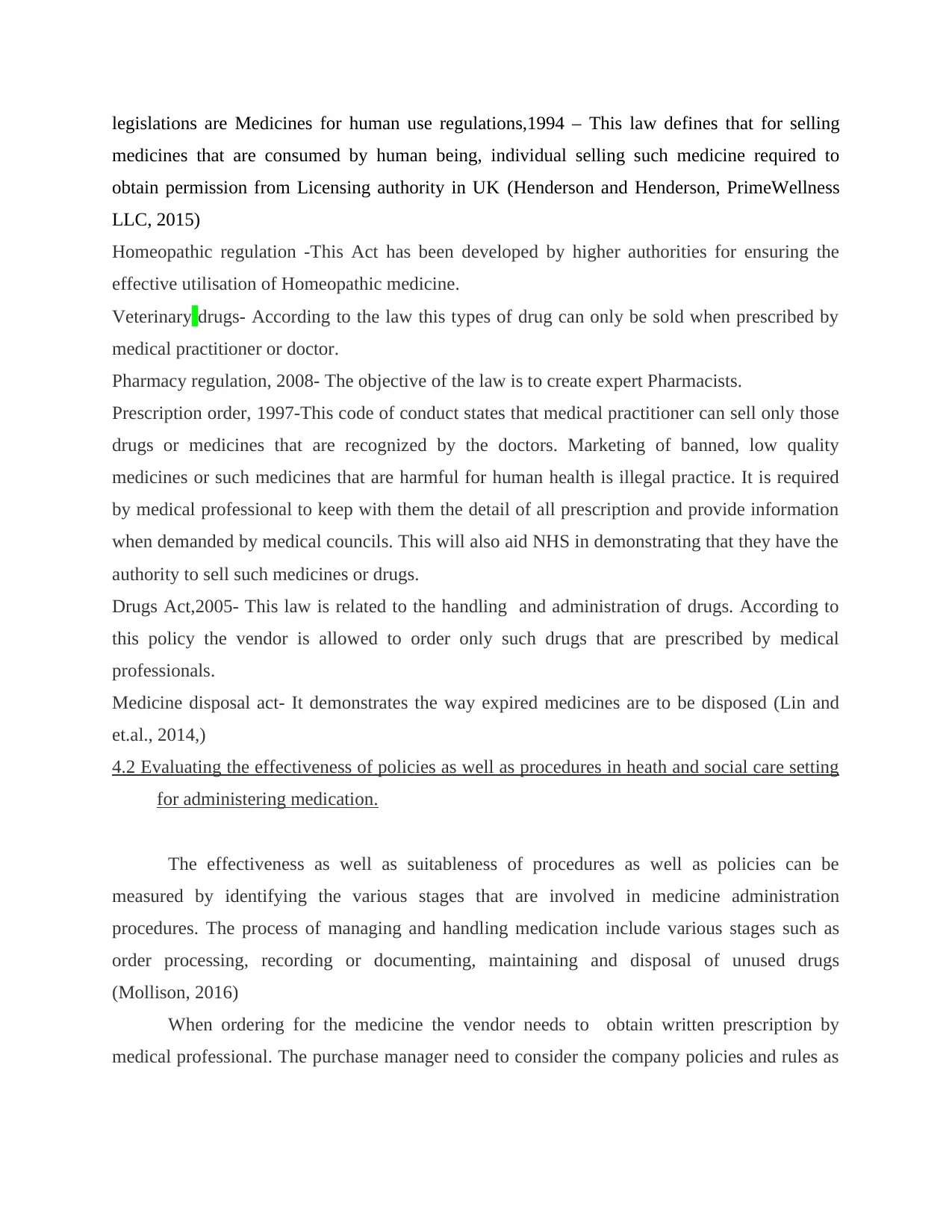
legislations are Medicines for human use regulations,1994 – This law defines that for selling
medicines that are consumed by human being, individual selling such medicine required to
obtain permission from Licensing authority in UK (Henderson and Henderson, PrimeWellness
LLC, 2015)
Homeopathic regulation -This Act has been developed by higher authorities for ensuring the
effective utilisation of Homeopathic medicine.
Veterinary drugs- According to the law this types of drug can only be sold when prescribed by
medical practitioner or doctor.
Pharmacy regulation, 2008- The objective of the law is to create expert Pharmacists.
Prescription order, 1997-This code of conduct states that medical practitioner can sell only those
drugs or medicines that are recognized by the doctors. Marketing of banned, low quality
medicines or such medicines that are harmful for human health is illegal practice. It is required
by medical professional to keep with them the detail of all prescription and provide information
when demanded by medical councils. This will also aid NHS in demonstrating that they have the
authority to sell such medicines or drugs.
Drugs Act,2005- This law is related to the handling and administration of drugs. According to
this policy the vendor is allowed to order only such drugs that are prescribed by medical
professionals.
Medicine disposal act- It demonstrates the way expired medicines are to be disposed (Lin and
et.al., 2014,)
4.2 Evaluating the effectiveness of policies as well as procedures in heath and social care setting
for administering medication.
The effectiveness as well as suitableness of procedures as well as policies can be
measured by identifying the various stages that are involved in medicine administration
procedures. The process of managing and handling medication include various stages such as
order processing, recording or documenting, maintaining and disposal of unused drugs
(Mollison, 2016)
When ordering for the medicine the vendor needs to obtain written prescription by
medical professional. The purchase manager need to consider the company policies and rules as
medicines that are consumed by human being, individual selling such medicine required to
obtain permission from Licensing authority in UK (Henderson and Henderson, PrimeWellness
LLC, 2015)
Homeopathic regulation -This Act has been developed by higher authorities for ensuring the
effective utilisation of Homeopathic medicine.
Veterinary drugs- According to the law this types of drug can only be sold when prescribed by
medical practitioner or doctor.
Pharmacy regulation, 2008- The objective of the law is to create expert Pharmacists.
Prescription order, 1997-This code of conduct states that medical practitioner can sell only those
drugs or medicines that are recognized by the doctors. Marketing of banned, low quality
medicines or such medicines that are harmful for human health is illegal practice. It is required
by medical professional to keep with them the detail of all prescription and provide information
when demanded by medical councils. This will also aid NHS in demonstrating that they have the
authority to sell such medicines or drugs.
Drugs Act,2005- This law is related to the handling and administration of drugs. According to
this policy the vendor is allowed to order only such drugs that are prescribed by medical
professionals.
Medicine disposal act- It demonstrates the way expired medicines are to be disposed (Lin and
et.al., 2014,)
4.2 Evaluating the effectiveness of policies as well as procedures in heath and social care setting
for administering medication.
The effectiveness as well as suitableness of procedures as well as policies can be
measured by identifying the various stages that are involved in medicine administration
procedures. The process of managing and handling medication include various stages such as
order processing, recording or documenting, maintaining and disposal of unused drugs
(Mollison, 2016)
When ordering for the medicine the vendor needs to obtain written prescription by
medical professional. The purchase manager need to consider the company policies and rules as
⊘ This is a preview!⊘
Do you want full access?
Subscribe today to unlock all pages.

Trusted by 1+ million students worldwide
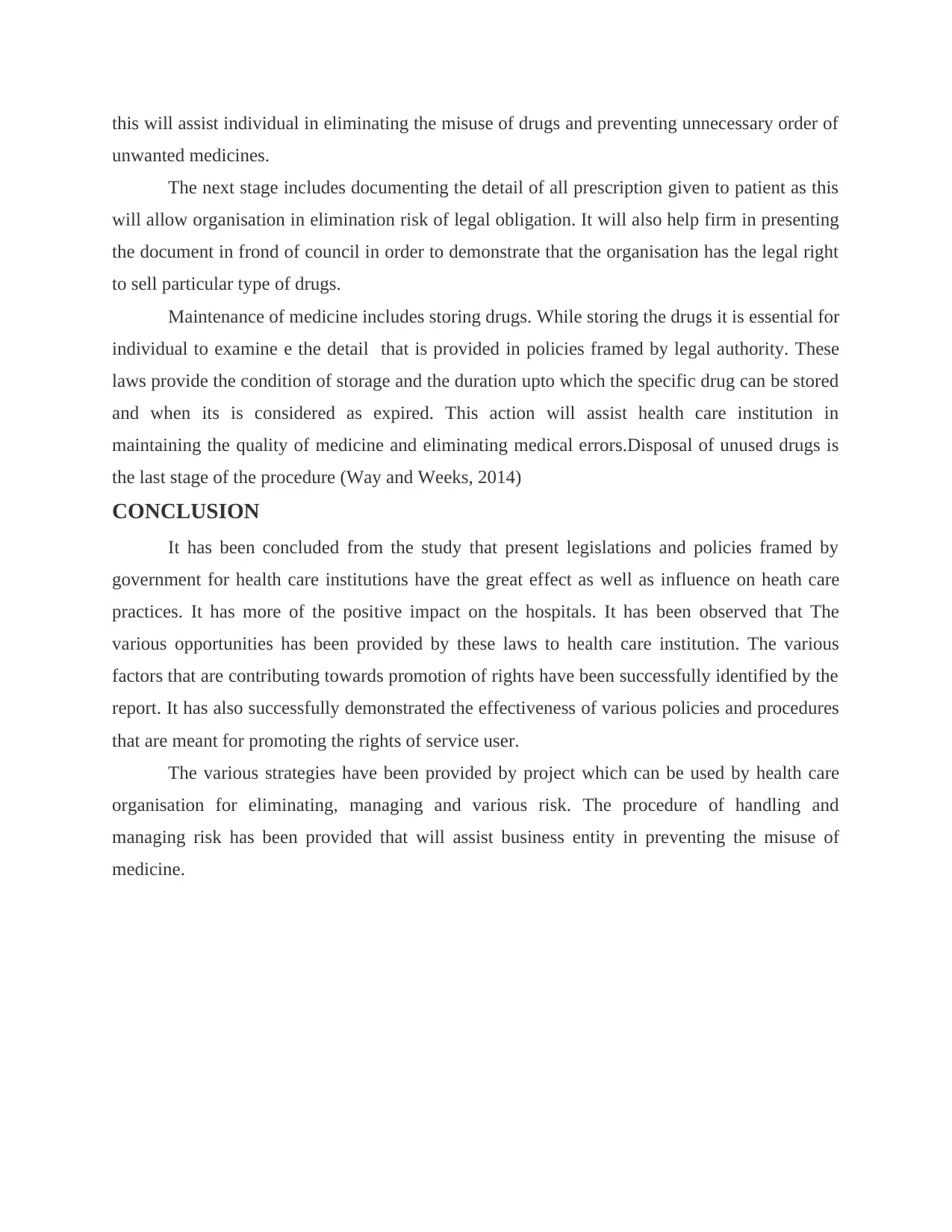
this will assist individual in eliminating the misuse of drugs and preventing unnecessary order of
unwanted medicines.
The next stage includes documenting the detail of all prescription given to patient as this
will allow organisation in elimination risk of legal obligation. It will also help firm in presenting
the document in frond of council in order to demonstrate that the organisation has the legal right
to sell particular type of drugs.
Maintenance of medicine includes storing drugs. While storing the drugs it is essential for
individual to examine e the detail that is provided in policies framed by legal authority. These
laws provide the condition of storage and the duration upto which the specific drug can be stored
and when its is considered as expired. This action will assist health care institution in
maintaining the quality of medicine and eliminating medical errors.Disposal of unused drugs is
the last stage of the procedure (Way and Weeks, 2014)
CONCLUSION
It has been concluded from the study that present legislations and policies framed by
government for health care institutions have the great effect as well as influence on heath care
practices. It has more of the positive impact on the hospitals. It has been observed that The
various opportunities has been provided by these laws to health care institution. The various
factors that are contributing towards promotion of rights have been successfully identified by the
report. It has also successfully demonstrated the effectiveness of various policies and procedures
that are meant for promoting the rights of service user.
The various strategies have been provided by project which can be used by health care
organisation for eliminating, managing and various risk. The procedure of handling and
managing risk has been provided that will assist business entity in preventing the misuse of
medicine.
unwanted medicines.
The next stage includes documenting the detail of all prescription given to patient as this
will allow organisation in elimination risk of legal obligation. It will also help firm in presenting
the document in frond of council in order to demonstrate that the organisation has the legal right
to sell particular type of drugs.
Maintenance of medicine includes storing drugs. While storing the drugs it is essential for
individual to examine e the detail that is provided in policies framed by legal authority. These
laws provide the condition of storage and the duration upto which the specific drug can be stored
and when its is considered as expired. This action will assist health care institution in
maintaining the quality of medicine and eliminating medical errors.Disposal of unused drugs is
the last stage of the procedure (Way and Weeks, 2014)
CONCLUSION
It has been concluded from the study that present legislations and policies framed by
government for health care institutions have the great effect as well as influence on heath care
practices. It has more of the positive impact on the hospitals. It has been observed that The
various opportunities has been provided by these laws to health care institution. The various
factors that are contributing towards promotion of rights have been successfully identified by the
report. It has also successfully demonstrated the effectiveness of various policies and procedures
that are meant for promoting the rights of service user.
The various strategies have been provided by project which can be used by health care
organisation for eliminating, managing and various risk. The procedure of handling and
managing risk has been provided that will assist business entity in preventing the misuse of
medicine.
Paraphrase This Document
Need a fresh take? Get an instant paraphrase of this document with our AI Paraphraser

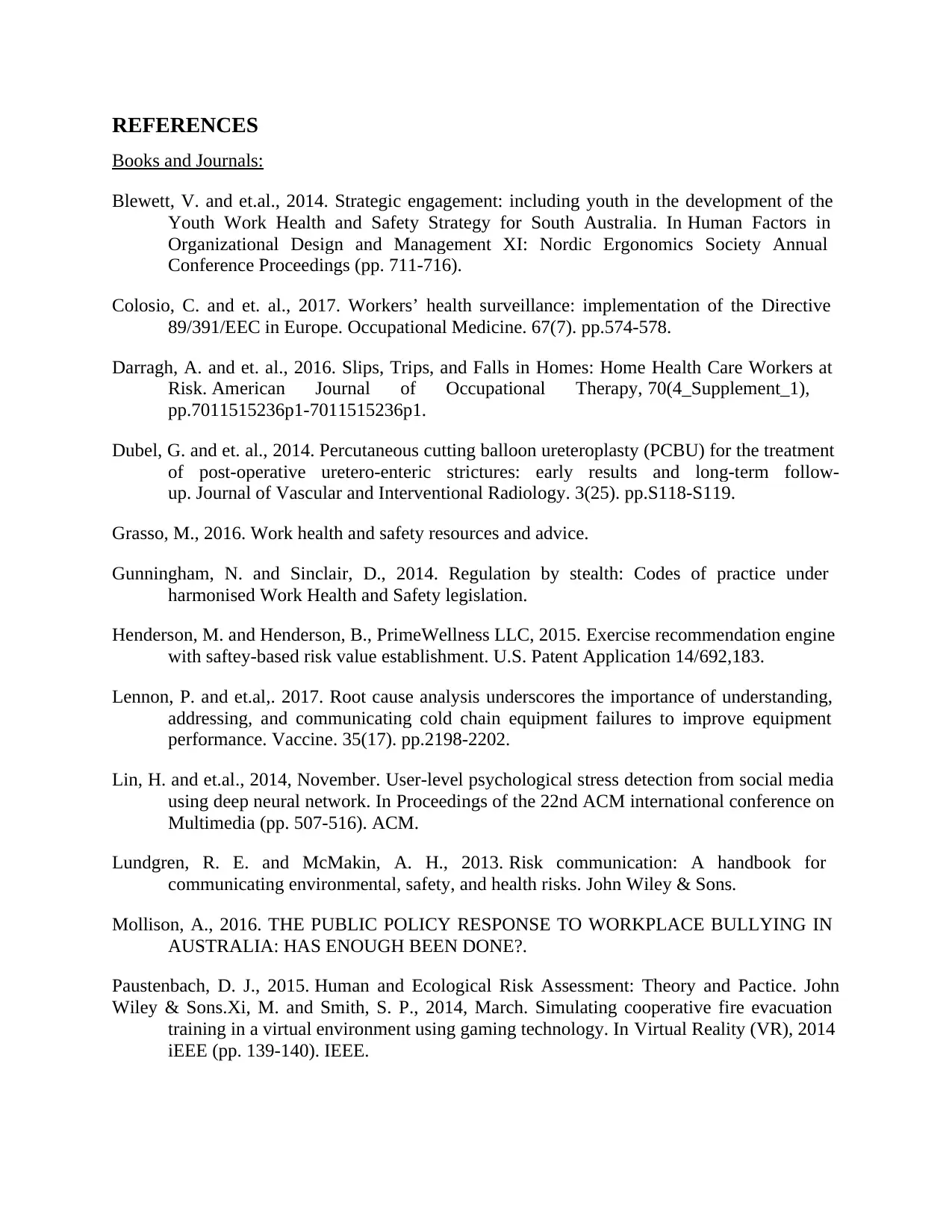
REFERENCES
Books and Journals:
Blewett, V. and et.al., 2014. Strategic engagement: including youth in the development of the
Youth Work Health and Safety Strategy for South Australia. In Human Factors in
Organizational Design and Management XI: Nordic Ergonomics Society Annual
Conference Proceedings (pp. 711-716).
Colosio, C. and et. al., 2017. Workers’ health surveillance: implementation of the Directive
89/391/EEC in Europe. Occupational Medicine. 67(7). pp.574-578.
Darragh, A. and et. al., 2016. Slips, Trips, and Falls in Homes: Home Health Care Workers at
Risk. American Journal of Occupational Therapy, 70(4_Supplement_1),
pp.7011515236p1-7011515236p1.
Dubel, G. and et. al., 2014. Percutaneous cutting balloon ureteroplasty (PCBU) for the treatment
of post-operative uretero-enteric strictures: early results and long-term follow-
up. Journal of Vascular and Interventional Radiology. 3(25). pp.S118-S119.
Grasso, M., 2016. Work health and safety resources and advice.
Gunningham, N. and Sinclair, D., 2014. Regulation by stealth: Codes of practice under
harmonised Work Health and Safety legislation.
Henderson, M. and Henderson, B., PrimeWellness LLC, 2015. Exercise recommendation engine
with saftey-based risk value establishment. U.S. Patent Application 14/692,183.
Lennon, P. and et.al,. 2017. Root cause analysis underscores the importance of understanding,
addressing, and communicating cold chain equipment failures to improve equipment
performance. Vaccine. 35(17). pp.2198-2202.
Lin, H. and et.al., 2014, November. User-level psychological stress detection from social media
using deep neural network. In Proceedings of the 22nd ACM international conference on
Multimedia (pp. 507-516). ACM.
Lundgren, R. E. and McMakin, A. H., 2013. Risk communication: A handbook for
communicating environmental, safety, and health risks. John Wiley & Sons.
Mollison, A., 2016. THE PUBLIC POLICY RESPONSE TO WORKPLACE BULLYING IN
AUSTRALIA: HAS ENOUGH BEEN DONE?.
Paustenbach, D. J., 2015. Human and Ecological Risk Assessment: Theory and Pactice. John
Wiley & Sons.Xi, M. and Smith, S. P., 2014, March. Simulating cooperative fire evacuation
training in a virtual environment using gaming technology. In Virtual Reality (VR), 2014
iEEE (pp. 139-140). IEEE.
Books and Journals:
Blewett, V. and et.al., 2014. Strategic engagement: including youth in the development of the
Youth Work Health and Safety Strategy for South Australia. In Human Factors in
Organizational Design and Management XI: Nordic Ergonomics Society Annual
Conference Proceedings (pp. 711-716).
Colosio, C. and et. al., 2017. Workers’ health surveillance: implementation of the Directive
89/391/EEC in Europe. Occupational Medicine. 67(7). pp.574-578.
Darragh, A. and et. al., 2016. Slips, Trips, and Falls in Homes: Home Health Care Workers at
Risk. American Journal of Occupational Therapy, 70(4_Supplement_1),
pp.7011515236p1-7011515236p1.
Dubel, G. and et. al., 2014. Percutaneous cutting balloon ureteroplasty (PCBU) for the treatment
of post-operative uretero-enteric strictures: early results and long-term follow-
up. Journal of Vascular and Interventional Radiology. 3(25). pp.S118-S119.
Grasso, M., 2016. Work health and safety resources and advice.
Gunningham, N. and Sinclair, D., 2014. Regulation by stealth: Codes of practice under
harmonised Work Health and Safety legislation.
Henderson, M. and Henderson, B., PrimeWellness LLC, 2015. Exercise recommendation engine
with saftey-based risk value establishment. U.S. Patent Application 14/692,183.
Lennon, P. and et.al,. 2017. Root cause analysis underscores the importance of understanding,
addressing, and communicating cold chain equipment failures to improve equipment
performance. Vaccine. 35(17). pp.2198-2202.
Lin, H. and et.al., 2014, November. User-level psychological stress detection from social media
using deep neural network. In Proceedings of the 22nd ACM international conference on
Multimedia (pp. 507-516). ACM.
Lundgren, R. E. and McMakin, A. H., 2013. Risk communication: A handbook for
communicating environmental, safety, and health risks. John Wiley & Sons.
Mollison, A., 2016. THE PUBLIC POLICY RESPONSE TO WORKPLACE BULLYING IN
AUSTRALIA: HAS ENOUGH BEEN DONE?.
Paustenbach, D. J., 2015. Human and Ecological Risk Assessment: Theory and Pactice. John
Wiley & Sons.Xi, M. and Smith, S. P., 2014, March. Simulating cooperative fire evacuation
training in a virtual environment using gaming technology. In Virtual Reality (VR), 2014
iEEE (pp. 139-140). IEEE.
⊘ This is a preview!⊘
Do you want full access?
Subscribe today to unlock all pages.

Trusted by 1+ million students worldwide
1 out of 13
Related Documents
Your All-in-One AI-Powered Toolkit for Academic Success.
+13062052269
info@desklib.com
Available 24*7 on WhatsApp / Email
![[object Object]](/_next/static/media/star-bottom.7253800d.svg)
Unlock your academic potential
Copyright © 2020–2025 A2Z Services. All Rights Reserved. Developed and managed by ZUCOL.





